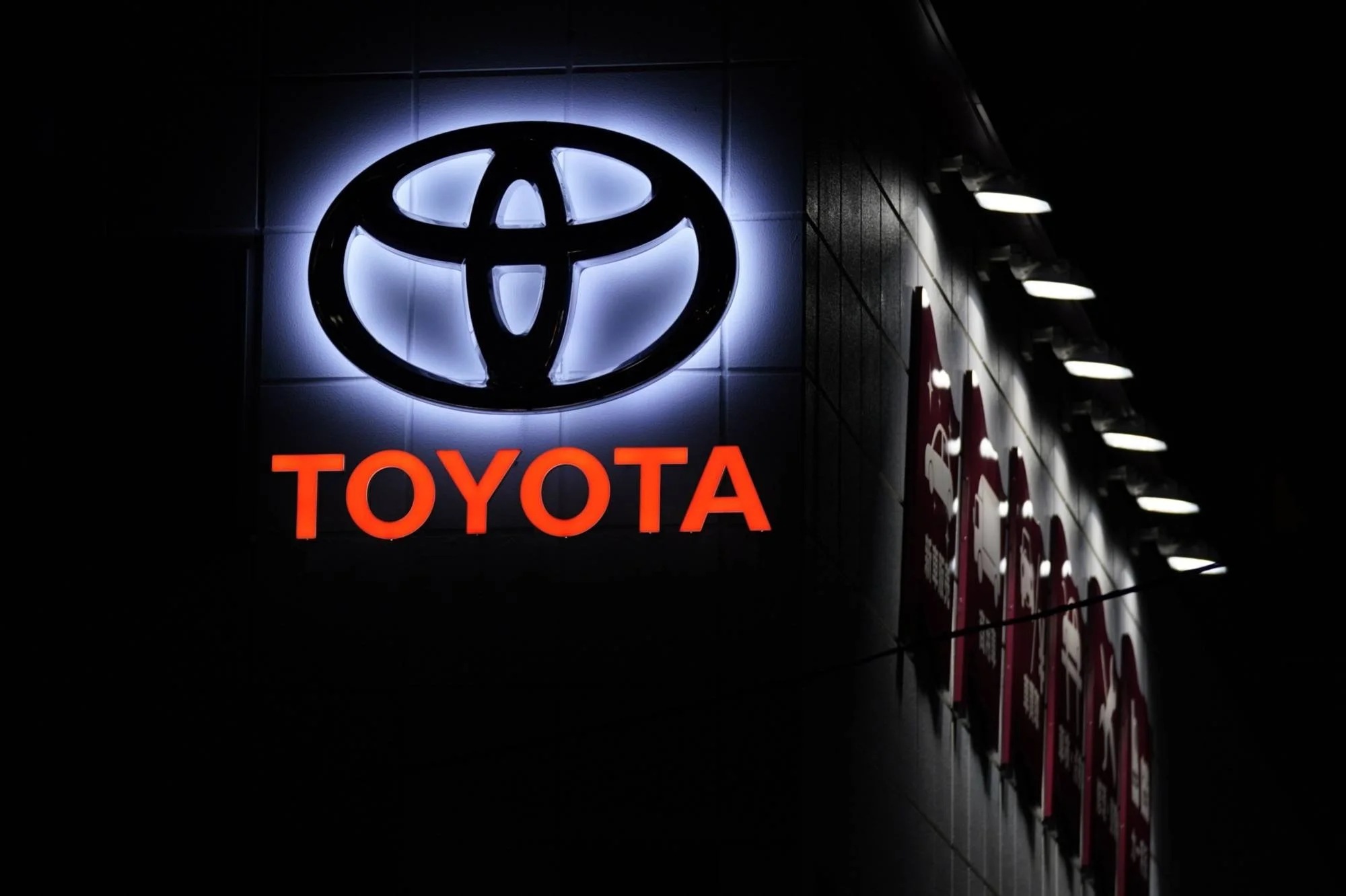
KUTIC Insights
Toyota: Navigating Strength, Strain, and the Road Ahead
By Luke Sloman
Published June 10th 2025
Introduction
Toyota Motor Corporation, long hailed as a paragon of automotive excellence and operational discipline, now finds itself navigating an increasingly complex and volatile landscape. While it remains the world’s largest carmaker by volume and a global leader in hybrid technology, a combination of geopolitical shocks, regulatory scrutiny, evolving consumer expectations, and rapid technological disruption is testing the very foundations of its dominance. In recent months, Toyota has confronted serious quality assurance issues, mounting pressure to accelerate its electrification strategy, and escalating trade tensions that threaten its global profitability.
This report explores five key areas shaping Toyota’s current trajectory: its financial and organizational resilience, its evolving electrification strategy, the reputational fallout from its certification scandals, the operational impact of rising tariffs, and the company’s leadership and cultural evolution. Together, these themes reveal a company in transition, one seeking to balance its legacy strengths with the urgent need to adapt to a dramatically changing global automotive industry.
Financial Foundations & Organizational Positioning
Toyota’s core remains strong. For FY2024, the company recorded record sales of ¥48 trillion ($334 billion), driven by resilient hybrid demand and operational discipline. Net profit stood at ¥4.77 trillion, down slightly from ¥4.94 trillion in FY2023, with operating profit reaching ¥4.3 trillion, a slight year-over-year decline but still formidable .
However, FY2025 signals a close-up challenge. Facing a 25% U.S. auto tariff, Toyota now forecasts a ~35% drop in net income to ¥3.1 trillion, a forecast driven by tariff costs (~¥180 billion) and a strong yen (~¥745 billion hit). Quarterly profit in early 2025 dropped nearly 28%, signaling mounting pressure.
Organisationally, Toyota is streamlining. Its proposal to fully acquire Toyota Industries (¥4.7 trillion offer) marks both a consolidation of its affiliate ecosystem and a defense against activist investors. Meanwhile, more functions, battery tech, software, and autonomy, are being centralized under Toyota Motor, shedding complexity in preparation for rapid innovation cycles.
In summary, Toyota remains financially dominant but is being tested by macroeconomic volatility. Its structural adjustments hint at strategic foresight, but also underline emerging fractures in its global dominance.
Electrification Strategy: A Cautious Crossroads
Toyota leads hybrids, but its BEV transition continues at a measured pace. While competitors raced ahead, Toyota remains committed to a diversified “multi-path” approach, combining HEVs, PHEVs, FCEVs, and BEVs.
It intends to offer 30 EV models by 2030, initially targeting 1 million BEV sales by 2026, down from earlier ambitions. Key models include the bZ4X, Urban Cruiser, C-HR+, and Lexus RZ for Europe, with nine BEVs planned under Toyota/Lexus brands by 2026.
Yet Toyota remains conservative. North American EV production has been delayed until mid-2026, as design, demand, and strategic considerations are reassessed. In China, whose EV market is exploding, Toyota pivoted by activating local battery and EV plants, following Tesla’s model, with a Shanghai plant set to support 100,000 Lexus EVs by 2027.
Innovatively, Toyota is also investing $14 billion in a North Carolina battery plant and pursuing solid-state batteries for commercialization by 2029. While technically promising, these remain long-term plays, and the company is still met with skepticism for its gradualism .
So, Toyota is accelerating, but with caution. While this hedges against BEV unpredictability and infrastructure limits, it risks lagging behind aggressively electrifying competitors, especially in critical markets like China and Europe.
Quality Control & Certification Crisis
Toyota’s reputation for quality, a hallmark of its brand, took a hit in 2024. In June, years of falsified certification data across models like Corolla and Yaris prompted the suspension of shipments, production halts, and regulatory backlash .
The recall and production stoppages spanned months and impacted volumes in Japan (–19%) and China (–22%) . Financially, Toyota incurred ¥332 billion (~$2.3 billion) in related expenses .
Toyota responded aggressively: certification leaders revisited production lines personally, auditing stops until compliance was reinstated. The “Certification Jishuken” framework was introduced within its Production System to embed governance culture in operations . Model-specific recall actions, such as brake fluid leaks affecting over 100,000 U.S. vehicles, continued into 2025, though costs were moderate ($10–50 million range).
Restoring confidence remains critical. While Toyota aggressively defended safety, it also pledged cultural reform. Whether stakeholders, from consumers to regulators, embrace its revamped compliance could determine Toyota’s ability to reassert quality leadership.
Trade Dynamics & Tariff Risks
Toyota now confronts a shifting trade environment. With the adoption of sweeping U.S. auto tariffs and a surged yen, near-term profits face material challenges. The estimated ¥180 billion tariff and ¥745 billion currency costs represent a nearly ¥1 trillion drag on earnings in FY2025.
Operationally, Toyota is responding pragmatically. North American manufacturing adjustments include increased EV and hybrid imports to Kentucky, Indiana, and Texas plants. The U.S. EV tariff also prompted reassessment of model sourcing, including the decision to ship Lexus EVs from Japan instead of building them locally .
Despite these adjustments, margins remain a concern. Toyota avoided immediate price hikes in the U.S., absorbing tariff costs upfront, a decision that may limit volume loss but shrink profit. Analysts argue consumer price increases are inevitable, even as automakers dispute this publicly .
Thus, Toyota is navigating trade volatility through a blend of supply chain adaptation, lobbying, and pricing maneuvering. Ultimately, the extent of relief, whether tariffs ease or currency stabilizes, will decide how severe the impact becomes.
Leadership, Governance, and Cultural Evolution
Toyota’s resilience is rooted in its leadership and governing culture, but both are under scrutiny. Akio Toyoda, the outgoing chairman and legacy figure, remains respected for steering Toyota through recalls, pandemics, and crises. But his long tenure and strategic dominance have drawn pressure for fresh governance .
In response, Toyota has strengthened board independence, reformed cross-shareholding structures, and initiated stake consolidation in affiliates. However, critics argue the full-seat on its affiliate’s board underscores a desire for continued control .
CEO Koji Sato, formerly Lexus chief, offers a fresher leadership tone infused with digital focus. His early actions, such as reinforcement of quality systems, tariff responses, and an emphasis on EV acceleration, signal proactive intent. Senior executives are collaborating with regulators on certification standards, seeking stronger compliance frameworks globally.
Culturally, the Toyota Production System (TPS) and kaizen remain central to the brand. The company is fusing these with digital oversight, formal compliance audits, and cross-border governance initiatives. Yet the transition from a lean hardware-first culture to software-driven mobility requires deep organizational transformation, something Toyota acknowledges by rebuilding its tech and battery operations under unified control .
Toyota’s ability to adapt its ethos, preserving operational excellence while embracing agile, digital, and accountable systems, will determine whether it can operate successfully in future-facing business models.
Conclusion
Toyota stands at a critical inflection point. Its scale, hybrid dominance, and global presence remain formidable, even as near-term profit pressure, quality issues, EV lag, and tariff threats challenge its historic stability.
Yet, the same responses that define Toyota’s resilience are in motion: structural simplification, selective acceleration in EVs and batteries, QA culture reform, nimble production realignments, and governance modernization. These moves align with Toyota’s conservative yet rigorous ethos.
The road ahead requires Toyota to balance calculated patience with decisive adaptation, leaning on its hybrid leadership while fast-tracking BEVs, deploying atomic quality culture across operations while restoring brand trust, and navigating global trade headwinds while balancing margin and delivery targets.
If Toyota can integrate these five critical domains, profit resilience, EV agility, quality governance, trade agility, and leadership evolution, it can reframe today’s turbulence as tomorrow’s foundation.
In summary, Toyota remains far from crisis, but tussling with global transformation in real time. Its strengths provide a shield, but success now depends less on legacy systems and more on timely adaptation: maintaining tradition while leading forward.
Disclaimer: This content is for informational and educational purposes only and does not constitute financial, investment, or other professional advice. The views expressed are our own and do not reflect the views of any institution we may be affiliated with. We are not licensed financial advisors, and nothing in this publication should be interpreted as a recommendation to buy or sell any securities. Please do your own research or consult a licensed professional before making any investment decisions.
